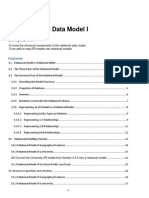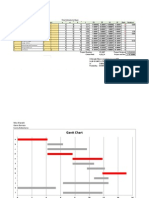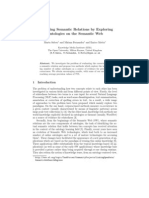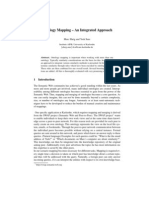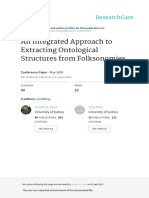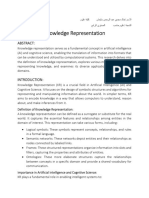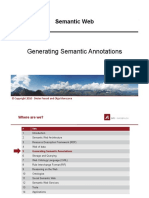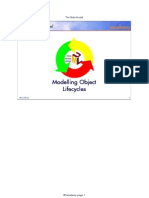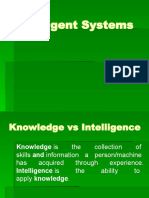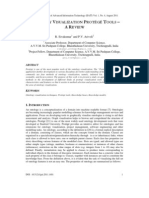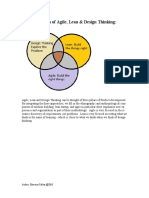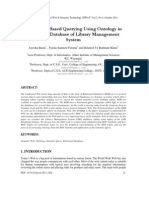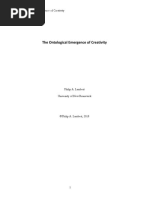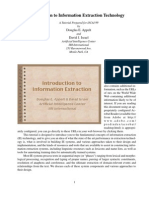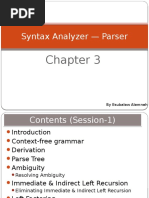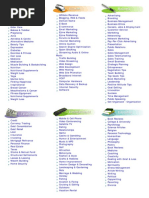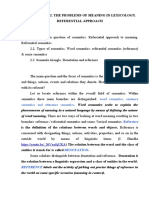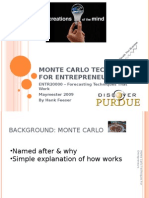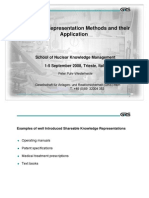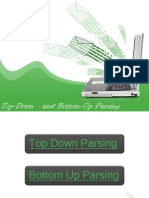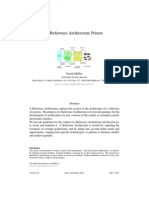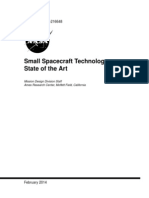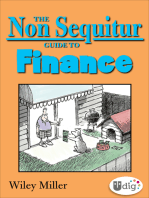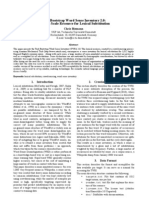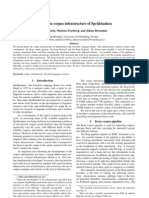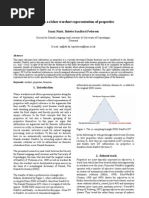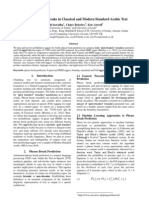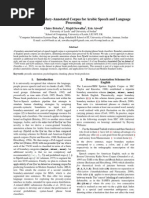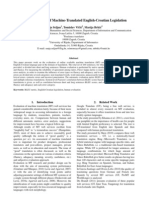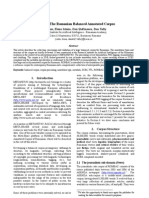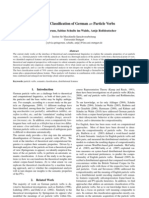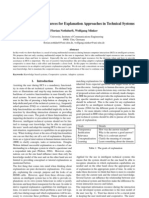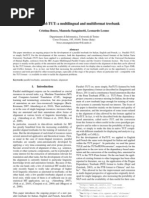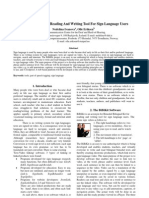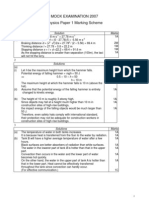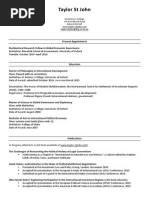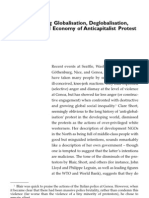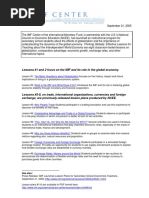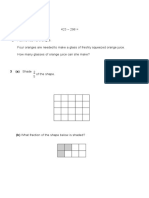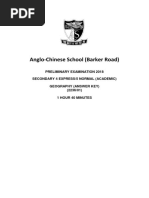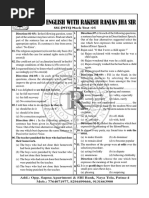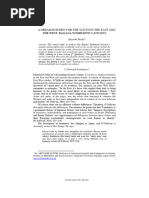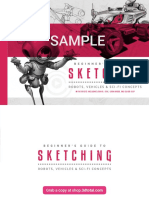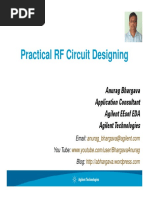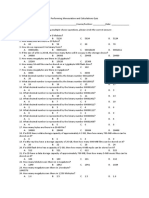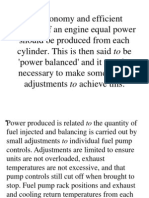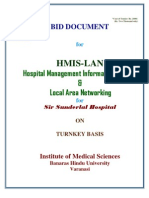A Classification of Adjectives For Polarity Lexicons Enhancement
A Classification of Adjectives For Polarity Lexicons Enhancement
Uploaded by
acouillaultCopyright:
Available Formats
A Classification of Adjectives For Polarity Lexicons Enhancement
A Classification of Adjectives For Polarity Lexicons Enhancement
Uploaded by
acouillaultOriginal Title
Copyright
Available Formats
Share this document
Did you find this document useful?
Is this content inappropriate?
Copyright:
Available Formats
A Classification of Adjectives For Polarity Lexicons Enhancement
A Classification of Adjectives For Polarity Lexicons Enhancement
Uploaded by
acouillaultCopyright:
Available Formats
A Classification of Adjectives for Polarity Lexicons Enhancement
Silvia Vzquez, Nria Bel
Universitat Pompeu Fabra Roc Boronat 138 08018, Barcelona E-mail: silvia.vazquez@upf.edu, nuria.bel@upf.edu Abstract
Subjective language detection is one of the most important challenges in Sentiment Analysis. Because of the weight and frequency in opinionated texts, adjectives are considered a key piece in the opinion extraction process. These subjective units are more and more frequently collected in polarity lexicons in which they appear annotated with their prior polarity. However, at the moment, any polarity lexicon takes into account prior polarity variations across domains. This paper proves that a majority of adjectives change their prior polarity value depending on the domain. We propose a distinction between domain dependent and domain independent adjectives. Moreover, our analysis led us to propose a further classification related to subjectivity degree: constant, mixed and highly subjective adjectives. Following this classification, polarity values will be a better support for Sentiment Analysis. Keywords: Sentiment Analysis; Opinion Mining; Polarity Lexicon
1.
Introduction
The amount of available information on the Internet is continuously growing. Now, surfing the web to find not only news (objective data) but also opinions (subjective data) has became a daily practice for all of us. People search from opinions about the latest political campaign to product reviews before going shopping. Therefore, the markets have realized that, being able to automatically extract the opinions conveyed in these texts, they can better understand the needs of their customers and they can set up more real and competitive commercial strategies. Therefore, subjective language detection is one of the most important challenges for Sentiment Analysis. To achieve that objective, developing tools that allow the extraction of the appropriate information from these opinionated texts is necessary. One of the tasks in which tool developers spend more time and efforts is the production of language resources used in the first steps of the opinion mining analysis: polarity lexicons. These are compilations of large amounts of words that tend to appear in opinionated texts. Moreover, all of these words are annotated with their prior polarity, that is, with their semantic orientation (i.e. positive or negative). However, opinion words collected in these polarity lexicons usually overlook prior polarity variations across domains. One example of this variation can be seen in the adjective small. It will be considered by a majority of people as a good characteristic for mobile phones, however if someone ask if having a small car is good, some people will answer yes and others will answer no. Moreover, if we also ask about a small film probably people wont know how to answer to our question. In this work we demonstrate the high impact of polarity variation depending on the domain, specifically for adjectives, after the comparison of prior polarity values of 514 adjectives across three different domains. For this
purpose, we compile three domain corpora (cars, mobile phones and films) and extracted common adjectives to compare their polarities. All of these units were manually annotated by 5 human annotators with their prior polarity. As a result, we proved that more than half of these units (67.32%) have a polarity that is domain dependent. Moreover, the annotation task revealed that, for some adjectives, human annotators showed very little agreement in what seems to be a phenomenon related to subjectivity. By measuring this new source of variation with standard deviation metrics, we could classify polarity adjectives in three different categories depending on the prior polarity perceived by the annotators: constant, mixed and highly subjective. The proof of the high impact of domain polarity variation of particular adjectives is meant to improve the future accuracy of polarity lexicons by turning them into much more reliable resources. Tools could take into account polarity differences between domains but also the existence of several elements that could be considered very unreliable, since they do not have a fixed polarity, or in contrast, reliable constant units, since they always have the same prior polarity in all domains. Thus, polarity lexicons would be annotated in a more accurate way and would therefore improve the efficiency of opinion mining tools. The paper is organized as follows. In section 2, we present related work in this field. In section 3, we describe the experiments that we carried out. In section 4, we present the analysis of results. Finally, in section 5 we report on the conclusions and future work.
2.
Related work
In the literature we can find several attempts to produce polarity lexicons in the last years. One of the resources
3557
most well-known is SentiWordNet1 (Esuli and Sebastiani, 2006; Bacianella et al., 2010) in which each WordNet (Miller, 1995) synset has one of three possible values: Objective, Positive or Negative. The basic idea is that different senses of the same term can have different properties related to opinion. Valitutti (2004) also tried to improve WordNets potential by adapting it to polarity issues and identifying all of the lexical elements that have a high load of emotional or affective content against the units that do not express emotion or affect. Another different method also based on WordNet exploration was done in Hu and Liu (2004). They used a very little set of seed adjectives annotated with their prior polarity. With this information, they found the synset of each seed adjective and also its antonyms. The polarity of an adjective that is in the synset of a seed adjective would be the same as the seed adjective. On the other hand, the polarity of an adjective that is in its antonym set would have the opposite. Vegnaduzzo (2004) presented a method to automatically build dictionaries using only a POS tagged corpus and a set of seed subjective adjectives. He had hypothesized that adjectives more likely to be subjective are those that are more similar in terms of their context to the adjectives in the seed set. Some of the latest work has been carried out by Rao and Ravichandran (2009) and Velikovich et al. (2010). Rao and Ravichandran used lexical resources such as WordNet and OpenOffice Thesaurus, while Velikovich et al. presented web-based approaches. Both showed how to detect polarity of the subjective words used in opinionated texts through lexical graphs where the polarity of some known nodes is propagated to other unknown nodes through the edges. However, none of these works takes into account prior polarity variation across domains. Our work proves the impact of this variation and classifies adjectives based upon it. On the other hand, much of the research on opinion adjectives, in particular, was performed by Wiebe (Hatzivassiloglou and Wiebe, 2000; Wiebe and Wilson, 2002; Riloff and Wiebe, 2003). Here it was shown that the most evident cues of subjectivity are adjectives, more than verbs or n-grams. These units were referred as strongly subjective clues. The study of adjectives behavior, their frequency as well as their weight in opinion texts, is crucial to improve polarity lexicons and the accuracy of analysis tools. Our goal is to prove the high presence of domain dependent elements to demonstrate why polarity lexicons should be adapted to this variability.
3.
Experiments
To assess the impact of domain variation, we compared adjectives that appeared in different domains. For this purpose, we built three opinion text corpora of different domains and all of the adjectives that appeared in the three domains were annotated by five human annotators. The comparison of the values received (see 3.2) showed that the number of domain dependent adjectives was more than the double of independent ones. Moreover, the comparison of the annotations made by different annotators showed a high variation not only across domains but also in the same domain. Further analysis confirmed a new classification: constant, mixed and highly subjective adjectives.
3.1 Corpora
We have built three corpora (300K words each) from three different domains: cars, mobile phones and films. All of the texts were extracted from Ciao2, a website specialized in user evaluations. We decided to use this site for its high-quality reviews, as users are paid to complete the tasks and because all of the texts are written in Spanish, the language of interest for our experiment. Texts were annotated using Freeling3 POS tagger (Padr et al. 2010). Then all of the units tagged as adjectives were extracted. We extracted the lemma of each adjective that appeared simultaneously in the three domains to compare their polarities. Finally, we obtained a list of 514 lemmas.
3.2 Polarity Annotation and Agreement
In order to determine the polarity of each lemma, five human annotators tagged each one. Annotation instructions were the following: -1 if the adjective is felt to be a negative feature, relative to the target domain. 0 if the adjective is felt to be irrelevant, not clearly related with a positive or negative feature to the target domain. 1 if the adjective is felt to be a positive feature, relative to the target domain.
All of the five human annotators were trained during two sessions to do the task. All of them had higher education level and were frequent users of review websites. To measure the inter-annotator agreement we used the Kappa index (Siegel and Castellan, 1988). The values of the task were 0.59 for cars and mobile phones and 0.51 for films. These results showed that a domain such as films is more subjective (that is, annotators do not reach an agreement about the prior polarity of adjectives within this domain) than others, such as cars or mobile phones. These values gave us the first clue to think that some adjectives can have prior polarity variations not only across domains, but also within the same domain. Thus, we also used the standard deviation to measure this degree
2 3
http://sentiwordnet.isti.cnr.it/
http://www.ciao.es/ http://nlp.lsi.upc.edu/freeling/
3558
of variation within the same domain.
respectively. In other words, they are considered domain independent adjectives. On the other hand, pequeo (small) or espacioso (spacious) are considered good features for some domains but bad for others, i.e. they are domain dependent. Espacioso (spacious), for example, is perceived as positive for cars but as an irrelevant feature for films and mobile phones and pequeo (small) is positive for mobile phones, negative for cars and neutral for films. Type Domain independent Domain dependent Percentage 32.68% 67.32%
4.
Data Analysis
The first aim was to calculate a value that could give us a measure of the polarity of each adjective. We calculated the arithmetic mean of the values assigned by the human annotators. If the human value was higher than 0, the element was considered to have a general tendency to be positive, while if this value was lower than 0, it was considered to have a general tendency to be negative. We also discovered some neutral adjectives which always (or in the majority of the cases) had a value equal to 0. Finally, the cases in which there were two -1, one 0 and two 1 were also considered as neutral elements. For instance, adecuado (appropriate) had different values across the three domains but the arithmetical mean of all the tags is higher than 0, thus it tends to be positive. However, aburrido (boring) has only negative values, thus it tends to be negative in any domain. Finally, amarillo (yellow) was always annotated with neutral tags. Some examples of the calculated arithmetic mean based on the annotation of the human annotators can be seen in Table 1. Adjective Adecuado Aburrido Amarillo Cars 0.5 -1.0 0.0 Phones 0.5 -0.75 0.0 Films 0.5 -1.0 0.0
Table 2: Percentages of domain dependent and domain independent adjectives Additionally, standard deviation from the arithmetic mean of all the annotations gave us the means to classify adjectives in three different categories: mixed, constant and highly subjective adjectives. We can see specific results in Table 3. Type Highly subjective Mixed Constant Percentage 22.18% 46.5% 31.32%
Table 1: Arithmetic mean of adecuado (appropriate), aburrido (boring) and amarillo (yellow) The principal aim of this assessment was to determine the general tendency of our adjectives to be in one or another side of the polarity scale and discover the elements that are neutral for some domains. However, although the arithmetic mean showed us the general tendency of adjectives to be in a positive or negative group, we considered that it was not enough to uncover the real values of these elements. Therefore, we also calculated the standard deviation of all of the adjective tags over all domains and annotators. This value showed the dispersion or unification degree of opinions regarding the value of the arithmetic mean, besides the tendency of the adjective to be in a positive or a negative group. With these results, we have considered as domain independent all of the units that were unanimously tagged as neutral (25.49%), negative (5.84%) or positive (1.36%), independently of domain and annotator. We considered as domain dependent such units where tags change across domains. We can see the results in Table 2. For example, on the one hand, decepcionante (disappointing) and alucinante (amazing) are considered as negative and positive by all annotators,
Table 3: Percentages of constant, mixed and highly subjective adjectives Highly subjective adjectives have a high or very high standard deviation value in all the domains. This fact highlights the wide range of opinions about some adjectives from one annotator to another. Therefore, they are very subjective elements. There is no agreement about the annotation and they depend entirely on the subjectivity of each annotator. For example, antiguo (old) is perceived as a good characteristic for films or cars by some annotator but as a bad characteristic by others. The specific annotation of antiguo (old) can be seen in Table 4. Domain Cars Phones Films Annotation -1, -1, 1, -1, 1 -1,-1,-1,0,0 0,1,1,1,1
Table 4: Prior polarity annotations of antiguo (old) In the mixed adjectives group there are units with standard deviation values high or very high for a domain but with no deviation for other domains. These units are, obviously, domain dependent: in some cases, adjectives show a high subjective degree (that is, the annotators do not reach an agreement about its polarity) and in other cases the polarity of the adjective is clearly identified. An example is agresivo (aggressive) in which does not exist agreement among the annotators in cars or films but has
3559
total agreement among the annotators for mobile phones (as neutral). The specific annotation of aggressive (agresivo) can be seen in Table 5. Domain Cars Phones Films Annotation 0,1,0,1,-1 0,0,0,0,0 0,0,0,0,-1
methodology to automatically distinguish the semantic orientation of adjectives which prior polarity is unknown. Related to that, we are also working on the possibility of using these independent elements to increase the number of lexical entries that should be included in polarity lexicons, studying also interesting combinations like noun plus adjective. Future work also includes the study of domain dependent elements with the intention of creating a classification of similar domains that can be studied together in order to develop polarity lexicons that could be shared by different domains.
Table 5: Prior polarity annotations of agresivo (aggressive) The last group is made up of constant polarity adjectives, that is, adjectives whose standard deviation value is 0. In other words, annotators give the same tag to the adjective in all of the domains. In general, we could say that this group can be considered domain independent adjectives (except in the cases of fiable (reliable) and frgil (fragile), which in the domains of cars and mobile phones are positive and negative, respectively while in films they are unanimously neutral). These adjectives (with these exceptions) could be automatically tagged with their semantic orientation because, their values do not change. Some examples are bello (beautiful) or psimo (dreadful) that have the same tag among all of the annotators across all the domains. The specific annotation of beautiful (bello) can be seen in Table 6. Domain Cars Phones Films Annotation 1,1,1,1,1 1,1,1,1,1 1,1,1,1,1
6.
Acknowledgements
This work was funded by the UPF-IULA PhD grant program.
7.
References
Baccianella, S., Esuli, A., Sebastiani, F. (2010). SentiWordNet 3.0: An enhanced lexical resource for sentiment analysis and opinin mining. In Proceedings of the Seventh conference on international Language Resources and Evaluation (LREC). Esuli, S., and Sebastiani, F. (2006). SENTIWORDNET : A publicly available resource for opinion mining. In Proceedings of Language Resources and Evaluation (LREC). Hatzivassiloglou, V., and Wiebe, J. (1990). Effects of Adjective Orientation and Gradability on Sentence Subjectivity. In Proceedings of the International Conference on Computational Linguistics (COLING). Hu, M., and Liu, B. (2004). Mining and summarizing customers reviews. In Proceedings of the ACM SIKDD Conference on Knowledge Discovery and Data Mining (KDD), 168-177 . Padr, L., Collado, M., Reese, S. Lloberes, M., and Castelln, I. (2010). Freeling 2.1: Five Years of Open-Source Language Processing Tools. In Proceedings of 7th Language Resources and Evaluation Conference (LREC 2010), ELRA, La Valetta, Malta. http://nlp.lsi.upc.edu/freeling Rao, D., and Ravichandran, D. (2009). Semi-supervised polarity lexicon induction. In Proceedings of the 12th Conference of the European Chapter of the Association for Computational Linguistics, 675-682. Riloff, E., and Wiebe, J. (2003) Learning Extraction Patterns for Subjective Expressions. In Proceedings of the Conference on Empirical Methods in Natural Language Processing (EMNLP). Siegel, S., and Castellan, N.J. (1988). Non parametric statistics for the behavioural sciences (2nd edition). New York, McGraw-Hill. Valitutti, R., and Stock, O. (2004). Developing Affective Lexical Resources. Psychology Journal, 2(1). Vegnaduzzo, S. (2004) Acquisition of Subjective
Table 6: Prior polarity annotations of beautiful (bello) Some examples of standard deviation values can be seen in the Table 7. Adjective Antiguo Agresivo Bello Cars 1.10 0.84 0.0 Phones 0.55 0.0 0.0 Films 0.45 0.45 0.0 Type Highly Subjective Mixed Constant
Table 7: Standard deviation of antiguo (old), agresivo (aggressive) and bello (beautiful)
5.
Conclusions
In this work we proved that there is variation in the annotation of the prior polarity of adjectives across domains. Our results indicate that a majority of adjectives are domain dependent elements and thus, we can not treat them as general units as it was done until now. The advantage of domain dependent lexicons would be to refine textual analysis depending on the topic and to increase the precision of our sentiment analysis tools. At present we are using all of the adjectives classified as domain independent elements as input of a bootstrapping
3560
Adjectives with Limited Resources. In Proceedings of the AAAI Spring Symposium on Exploring Attitude and Affect in Text: Theories and Applications. Velikovich, L., Blair-Goldensohn, S., Hannan, K., and McDonald, R. (2010). The viability of web-derived polarity lexicons. Human Language Technologies: The 2010 Annual Conference of the North American Chapter of the Association for Computational Linguistics, 777-785 Wiebe, J.,and Wilson, T. (2002). Learning to disambiguate potentially subjective expressions. In Proceedings of the Conference on Natural Language Learning (CoNLL), 112-118. Wilson, T., Wiebe, J., and Hoffmann, P. (2005). Recognizing contextual polarity in phrase-level sentiment analysis. In Proceedings of HTL/EMNLP.
3561
You might also like
- Drug Specification Named Entity Recognition Base On BiLSTM-CRF Model PDFDocument5 pagesDrug Specification Named Entity Recognition Base On BiLSTM-CRF Model PDFEduardo LacerdaNo ratings yet
- 3 RelModelDocument19 pages3 RelModelNilesh BhoyarNo ratings yet
- The Bloodless Coup Concert CaseDocument2 pagesThe Bloodless Coup Concert CaseNiko ManaliliNo ratings yet
- Evaluating Semantic Relations by Exploring Ontologies On The Semantic WebDocument12 pagesEvaluating Semantic Relations by Exploring Ontologies On The Semantic WebMarta SabouNo ratings yet
- Ontology Mapping - An Integrated Approach: Abstract. Ontology Mapping Is Important When Working With More Than OneDocument15 pagesOntology Mapping - An Integrated Approach: Abstract. Ontology Mapping Is Important When Working With More Than OneIanus72No ratings yet
- Comparing and Combining Semantic Verb ClassificationsDocument34 pagesComparing and Combining Semantic Verb ClassificationsDiniNo ratings yet
- Employing A Domain Specific Ontology To Perform Semantic SearchDocument13 pagesEmploying A Domain Specific Ontology To Perform Semantic Searchmona4No ratings yet
- An Integrated Approach To Extracting Ontological SDocument16 pagesAn Integrated Approach To Extracting Ontological SMaría MarchianoNo ratings yet
- Knowledge RepresentationDocument10 pagesKnowledge Representationrotago6843No ratings yet
- Generating Semantic AnnotationsDocument78 pagesGenerating Semantic AnnotationsPal Vadasz100% (1)
- Diff Classification and TaxonomyDocument8 pagesDiff Classification and Taxonomymanoj_thomas_9No ratings yet
- Simple Knowledge Organization System (SKOS) in 10 PointsDocument11 pagesSimple Knowledge Organization System (SKOS) in 10 PointsKaren Tinajero-VazquezNo ratings yet
- 013 State DiagramsDocument30 pages013 State Diagramsvidhya_bineeshNo ratings yet
- Simulation of Spacecraft Attitude and Orbit DynamicsDocument6 pagesSimulation of Spacecraft Attitude and Orbit DynamicsDan PhanNo ratings yet
- 18-08-Todoist Setup GuideDocument14 pages18-08-Todoist Setup GuideNickNo ratings yet
- Sparql 1 1 Cheat SheetDocument18 pagesSparql 1 1 Cheat SheetGonçalo PalaioNo ratings yet
- Start and End Dates For Recurring Tasks: Type This: To Add This Recurring Due DateDocument2 pagesStart and End Dates For Recurring Tasks: Type This: To Add This Recurring Due DateMilan DelićNo ratings yet
- Topic 1 Overview of Intelligent SystemsDocument35 pagesTopic 1 Overview of Intelligent SystemsPurvi ChaurasiaNo ratings yet
- Expert Systems With Applications: David Sánchez, Montserrat Batet, David Isern, Aida VallsDocument11 pagesExpert Systems With Applications: David Sánchez, Montserrat Batet, David Isern, Aida VallsSendari NoviaNo ratings yet
- Ontology Visualization Protégé Tools - A ReviewDocument11 pagesOntology Visualization Protégé Tools - A ReviewijaitjournalNo ratings yet
- An Intersection of Agile, Lean & IBM Design ThinkingDocument5 pagesAn Intersection of Agile, Lean & IBM Design ThinkingMinh Tân100% (1)
- Part I: Introduction 1 Why Study Automata Theory? 2 Languages and StringsDocument22 pagesPart I: Introduction 1 Why Study Automata Theory? 2 Languages and StringsMunirul FSNo ratings yet
- Abstractive Text Summary Generation With Knowledge Graph RepresentationDocument9 pagesAbstractive Text Summary Generation With Knowledge Graph RepresentationPrachurya NathNo ratings yet
- Comparative Study of Text Summarization MethodsDocument6 pagesComparative Study of Text Summarization Methodshagar.hesham.extNo ratings yet
- Aw DD512 Manual G11 110928Document40 pagesAw DD512 Manual G11 110928rafa8607No ratings yet
- Search Engine TechniquesDocument10 pagesSearch Engine TechniquesSrikanth AryanNo ratings yet
- Ontology Mapping Based On Similarity Measure and Fuzzy LogicDocument5 pagesOntology Mapping Based On Similarity Measure and Fuzzy LogicharzaghiNo ratings yet
- Semantic - Based Querying Using Ontology in Relational Database of Library Management SystemDocument12 pagesSemantic - Based Querying Using Ontology in Relational Database of Library Management SystemijwestNo ratings yet
- Similarity-Based Techniques For Text Document ClassificationDocument8 pagesSimilarity-Based Techniques For Text Document ClassificationijaertNo ratings yet
- The Ontological Emergence of Creativity PDFDocument34 pagesThe Ontological Emergence of Creativity PDFFelipe JosebaNo ratings yet
- Introduction To Information Extraction Technology: Douglas E. Appelt David J. IsraelDocument41 pagesIntroduction To Information Extraction Technology: Douglas E. Appelt David J. IsraelJumar Divinagracia DimpasNo ratings yet
- Techniques of Text ClassificationDocument28 pagesTechniques of Text ClassificationHouda KamoussNo ratings yet
- Tutorial On Ontological Engineering Part 2: Ontology Development, Tools and LanguagesDocument28 pagesTutorial On Ontological Engineering Part 2: Ontology Development, Tools and LanguagesCarvalho BentoNo ratings yet
- Ontology Creation: A Scratch Guide To Creating An OntologyDocument21 pagesOntology Creation: A Scratch Guide To Creating An OntologyWilliam C. De Souza CarvalhoNo ratings yet
- Abstract: 1 - Ontology and Database DesignDocument26 pagesAbstract: 1 - Ontology and Database Designseunnuga93No ratings yet
- Collaborative Tagging SystemsDocument8 pagesCollaborative Tagging Systemsbc2255No ratings yet
- Semantic Web DissertationDocument4 pagesSemantic Web DissertationCanYouWriteMyPaperForMeUK100% (1)
- Chapter 3 - Syntax AnalysisDocument88 pagesChapter 3 - Syntax AnalysisAnonymous zDRmfIpGfNo ratings yet
- Engineering Design Knowledge Representation Based On Logic and ObjectsDocument19 pagesEngineering Design Knowledge Representation Based On Logic and ObjectsnuesteNo ratings yet
- Word Semantics, Sentence Semantics and Utterance SemanticsDocument11 pagesWord Semantics, Sentence Semantics and Utterance SemanticsАннаNo ratings yet
- What Is OntologyDocument7 pagesWhat Is OntologyNorashikin Ahmad100% (1)
- Monte Carlo TechniquesDocument6 pagesMonte Carlo Techniquesentr200No ratings yet
- A Comparative Study of Ontology Building Tools in Semantic Web ApplicationsDocument13 pagesA Comparative Study of Ontology Building Tools in Semantic Web ApplicationsijwestNo ratings yet
- Keyword Extraction Issues and MethodsDocument33 pagesKeyword Extraction Issues and MethodsAlejandro Cuatecontzi AyalaNo ratings yet
- 024 KnowledgeRepresentationMethods (Puhr)Document18 pages024 KnowledgeRepresentationMethods (Puhr)anwarussaeedNo ratings yet
- Keyphrase Extraction (3rd Review)Document22 pagesKeyphrase Extraction (3rd Review)gowtham1990No ratings yet
- Top-Down and Bottom-Up ParsingDocument23 pagesTop-Down and Bottom-Up ParsingvanithaarivuNo ratings yet
- Langauage ModelDocument148 pagesLangauage ModelsharadacgNo ratings yet
- Conceptual Framework For Abstractive Text SummarizationDocument11 pagesConceptual Framework For Abstractive Text SummarizationDarrenNo ratings yet
- Interaction Design Lab - Week 01Document19 pagesInteraction Design Lab - Week 01Kim LongNo ratings yet
- Text SummerizationDocument11 pagesText SummerizationDejene TechaneNo ratings yet
- How To Read A Data ModelDocument51 pagesHow To Read A Data ModelSanjay SharmaNo ratings yet
- Folksonomies - Why Do We Need Controlled VocabularyDocument8 pagesFolksonomies - Why Do We Need Controlled VocabularytfnkNo ratings yet
- Reference Architecture Primer PaperDocument21 pagesReference Architecture Primer PaperAnaid GarciaNo ratings yet
- The Suggestion How To Manage A Perfect ProjectDocument10 pagesThe Suggestion How To Manage A Perfect ProjectAmy RahimNo ratings yet
- Semanti Web TechnologiesDocument11 pagesSemanti Web TechnologiesHarika MnNo ratings yet
- Small Spacecraft Technology State of The Art 2014Document208 pagesSmall Spacecraft Technology State of The Art 2014betamaksNo ratings yet
- Iso PDFDocument8 pagesIso PDFWardah TERRNo ratings yet
- Hands-On Dashboard Development with QlikView: Practical guide to creating interactive and user-friendly business intelligence dashboardsFrom EverandHands-On Dashboard Development with QlikView: Practical guide to creating interactive and user-friendly business intelligence dashboardsNo ratings yet
- Turk Bootstrap Word Sense Inventory 2.0: A Large-Scale Resource For Lexical SubstitutionDocument5 pagesTurk Bootstrap Word Sense Inventory 2.0: A Large-Scale Resource For Lexical SubstitutionacouillaultNo ratings yet
- Korp - The Corpus Infrastructure of Språkbanken: Lars Borin, Markus Forsberg, and Johan RoxendalDocument5 pagesKorp - The Corpus Infrastructure of Språkbanken: Lars Borin, Markus Forsberg, and Johan RoxendalacouillaultNo ratings yet
- 245 PaperDocument8 pages245 PaperacouillaultNo ratings yet
- The Open Lexical Infrastructure of SPR Akbanken: Lars Borin, Markus Forsberg, Leif-J Oran Olsson and Jonatan Uppstr OmDocument5 pagesThe Open Lexical Infrastructure of SPR Akbanken: Lars Borin, Markus Forsberg, Leif-J Oran Olsson and Jonatan Uppstr OmacouillaultNo ratings yet
- Towards A Richer Wordnet Representation of Properties: Sanni Nimb, Bolette Sandford PedersenDocument5 pagesTowards A Richer Wordnet Representation of Properties: Sanni Nimb, Bolette Sandford PedersenacouillaultNo ratings yet
- Predicting Phrase Breaks in Classical and Modern Standard Arabic TextDocument5 pagesPredicting Phrase Breaks in Classical and Modern Standard Arabic TextacouillaultNo ratings yet
- Timebankpt: A Timeml Annotated Corpus of Portuguese: Francisco Costa, Ant Onio BrancoDocument8 pagesTimebankpt: A Timeml Annotated Corpus of Portuguese: Francisco Costa, Ant Onio BrancoacouillaultNo ratings yet
- 240 PaperDocument6 pages240 PaperacouillaultNo ratings yet
- 233 PaperDocument6 pages233 PaperacouillaultNo ratings yet
- 232 PaperDocument7 pages232 PaperacouillaultNo ratings yet
- Conandoyle-Neg: Annotation of Negation in Conan Doyle StoriesDocument6 pagesConandoyle-Neg: Annotation of Negation in Conan Doyle StoriesacouillaultNo ratings yet
- ROMBAC: The Romanian Balanced Annotated Corpus: Radu Ion, Elena Irimia, Dan Ştefănescu, Dan TufișDocument6 pagesROMBAC: The Romanian Balanced Annotated Corpus: Radu Ion, Elena Irimia, Dan Ştefănescu, Dan TufișacouillaultNo ratings yet
- 230 PaperDocument6 pages230 PaperacouillaultNo ratings yet
- 228 PaperDocument8 pages228 PaperacouillaultNo ratings yet
- CAT: The CELCT Annotation Tool: Valentina Bartalesi Lenzi, Giovanni Moretti, Rachele SprugnoliDocument6 pagesCAT: The CELCT Annotation Tool: Valentina Bartalesi Lenzi, Giovanni Moretti, Rachele SprugnoliacouillaultNo ratings yet
- Automatic Classification of German An Particle Verbs: Sylvia Springorum, Sabine Schulte Im Walde, Antje RoßdeutscherDocument8 pagesAutomatic Classification of German An Particle Verbs: Sylvia Springorum, Sabine Schulte Im Walde, Antje RoßdeutscheracouillaultNo ratings yet
- 211 PaperDocument5 pages211 PaperacouillaultNo ratings yet
- LIE: Leadership, Influence and Expertise: R. Catizone, L. Guthrie, A.J. Thomas, and Y. WilksDocument5 pagesLIE: Leadership, Influence and Expertise: R. Catizone, L. Guthrie, A.J. Thomas, and Y. WilksacouillaultNo ratings yet
- 208 PaperDocument7 pages208 PaperacouillaultNo ratings yet
- The Parallel-TUT: A Multilingual and Multiformat Treebank: Cristina Bosco, Manuela Sanguinetti, Leonardo LesmoDocument7 pagesThe Parallel-TUT: A Multilingual and Multiformat Treebank: Cristina Bosco, Manuela Sanguinetti, Leonardo LesmoacouillaultNo ratings yet
- 210 PaperDocument5 pages210 PaperacouillaultNo ratings yet
- A Bilingual Bimodal Reading and Writing Tool For Sign Language UsersDocument5 pagesA Bilingual Bimodal Reading and Writing Tool For Sign Language UsersacouillaultNo ratings yet
- 204 PaperDocument8 pages204 PaperacouillaultNo ratings yet
- Detecting Reduplication in Videos of American Sign Language: Zoya Gavrilov, Stan Sclaroff, Carol Neidle, Sven DickinsonDocument7 pagesDetecting Reduplication in Videos of American Sign Language: Zoya Gavrilov, Stan Sclaroff, Carol Neidle, Sven DickinsonacouillaultNo ratings yet
- Mock Examination 2007 Physics Paper 1 Marking SchemeDocument6 pagesMock Examination 2007 Physics Paper 1 Marking Schemeapi-19650882No ratings yet
- CSC134 C3Document2 pagesCSC134 C3Aiman NabihahNo ratings yet
- ST John CV PDFDocument4 pagesST John CV PDFAmanda SmithNo ratings yet
- Sim Hydraulics Guide PDFDocument65 pagesSim Hydraulics Guide PDFVenkatesh Gangadhar100% (2)
- ConActually Existing Globalisation, Deglobalisation, and The Political Economy of Anticapitalist Protest Byray KielyDocument30 pagesConActually Existing Globalisation, Deglobalisation, and The Political Economy of Anticapitalist Protest Byray Kiely5705robinNo ratings yet
- Lesson1 PDFDocument11 pagesLesson1 PDFjoan gargaNo ratings yet
- Meshing in ANSYS WorkbenchDocument5 pagesMeshing in ANSYS Workbenchfr129834No ratings yet
- 1 Calculate: Math PracticeDocument7 pages1 Calculate: Math PracticeMary WidyaningsihNo ratings yet
- Law - Meaning Nature FunctionsDocument16 pagesLaw - Meaning Nature FunctionsHJ ManviNo ratings yet
- Sec 4 Geog P1 AnsDocument14 pagesSec 4 Geog P1 AnsJamesMinionNo ratings yet
- Company Profile UsmDocument8 pagesCompany Profile Usmnishantnamdeo75No ratings yet
- Example CalculationsDocument4 pagesExample CalculationsElla BowlingNo ratings yet
- Learn English With Rakesh Ranjan Jha Sir: Ith RakeDocument2 pagesLearn English With Rakesh Ranjan Jha Sir: Ith RakeHarshNo ratings yet
- G.berrios MentalDocument581 pagesG.berrios MentalRicardo Branco Julião100% (1)
- (London Mathematical Society Student Texts) John Meier-Groups, Graphs and Trees - An Introduction To The Geometry of Infinite Groups-Cambridge University Press (2008)Document245 pages(London Mathematical Society Student Texts) John Meier-Groups, Graphs and Trees - An Introduction To The Geometry of Infinite Groups-Cambridge University Press (2008)cisemalmali75% (4)
- Template Individual Assignment MGT 7023Document4 pagesTemplate Individual Assignment MGT 7023Nur SabriNo ratings yet
- Youth Leadership Summit: HON. Manuel PalarcaDocument7 pagesYouth Leadership Summit: HON. Manuel PalarcaCamilo GarciaNo ratings yet
- A Dream Kitchen For The Youth in The East and The West - Banana Yoshimoto's KitchenDocument16 pagesA Dream Kitchen For The Youth in The East and The West - Banana Yoshimoto's KitchenAmina ElsawafNo ratings yet
- Sampe SkethingDocument21 pagesSampe SkethingPhuong Nguyen BichNo ratings yet
- Practical RF Circuit Design PDFDocument47 pagesPractical RF Circuit Design PDFLOUKILkarim100% (1)
- A Melange of Deeper Work and Effective ExecutivesDocument9 pagesA Melange of Deeper Work and Effective ExecutivesVivitsa UpastiNo ratings yet
- G7 Math Q1 - Week 8-Decreasing and Increasing of NumbersDocument12 pagesG7 Math Q1 - Week 8-Decreasing and Increasing of NumbersPeterson Dela Cruz EnriquezNo ratings yet
- Kevin Gaskell July 2019Document90 pagesKevin Gaskell July 2019bobeluNo ratings yet
- Intro To DBMSDocument22 pagesIntro To DBMSapi-27570914100% (1)
- Performing Mensuration and Calculations QuizDocument2 pagesPerforming Mensuration and Calculations QuizArt Dollosa80% (5)
- 02 - Power BalancingDocument8 pages02 - Power Balancingveer sainNo ratings yet
- Shear Strength of SoilDocument13 pagesShear Strength of SoilfitprawNo ratings yet
- Hmis-Lan: Hospital Management Information System & Local Area NetworkingDocument33 pagesHmis-Lan: Hospital Management Information System & Local Area NetworkingNikhil SangarNo ratings yet
- Introduction To Descriptive StatisticsDocument18 pagesIntroduction To Descriptive StatisticsNashwa Saad100% (1)

